Sure, you’ve seen plenty of bee hives out and about, but how does urban beekeeping really work? To answer this question, we took a visit to an urban bee farm in Seattle.

Where Does Honey Come From?
The idea for visiting a bee farm came from a perfectly innocent question. When one of our kids recently asked us where exactly honey comes from, we fumbled the question. Our slightly embarrassing response went something like: “So the bee gathers pollen – or is it nectar? Then it goes to its hive, and then it…somehow… makes it into honey. Then it… eats it? Or uses it to make a honeycomb? Or…maybe we should look it up.”
We figure we’re not entirely alone in being fuzzy on the process, but given that we use honey so much, we thought we needed a better answer. So to tackle this all-important question, we took a Real Food Summer road trip to an urban beekeeping operation run through Seattle Bee Works.

Seattle Bee Works
Seattle Bee Works founder Krista Conner began beekeeping in 2007 with just two beehives stationed in a friend’s garden. Today Seattle Bee Works operates a growing number of beehives located throughout Seattle, offering homeowners the chance to host beehives in exchange for honey. Seattle Bee Works’ urban beekeeping practices are antibiotic and pesticide free. Krista, a cancer survivor, is extremely conscientious about avoiding impacts from chemicals and opting for organic products in her day-to-day life. She applies this same focus to her beekeeping practices when applying supplemental feeding to the bees or when choosing a mite control method.
Krista and two of her apprentices brought us to a private home and garden that houses several of Krista’s beehives. The gardeners that they had hired to maintain the garden had kept the garden spectacularly beautiful. We all suited up with head-to-toe protective gear that included a special mesh helmet, heavy gloves, and boots. While the beekeepers worked on hive maintenance we took pictures and asked questions.

The right stuff: Beekeepers are suited up and ready for a morning at the hives
 Bee Colonies
Bee Colonies
The bee colonies that we visited almost look like colorful sets of drawers. Each segment contains “frames,” kind of like screens but with honeycomb patterns that the beekeeper can pull apart and inspect. The beekeepers examine the frames to determine whether there are eggs and larvae (baby bees), how much honey the bees are making, and how the queen is doing.

Inspecting the frames in the bee hive
In each hive there is a queen bee (female), drones (males), and worker bees (females). The worker bees have different jobs depending on how old they are. The youngest bees are nurse bees that take care of the babies. The slightly older ones are guard bees that watch the hive. Then there are the foragers, who go out and get the nectar. These foragers literally work themselves to death over the summer. They make so many trips back and forth to the hive with their precious cargo that they only live for a little more than a month. The queen bees reign for one to two – up to as many as five – years. If they are thriving, the hive is successful; if the queen’s health is failing, her fellow bees will replace her.
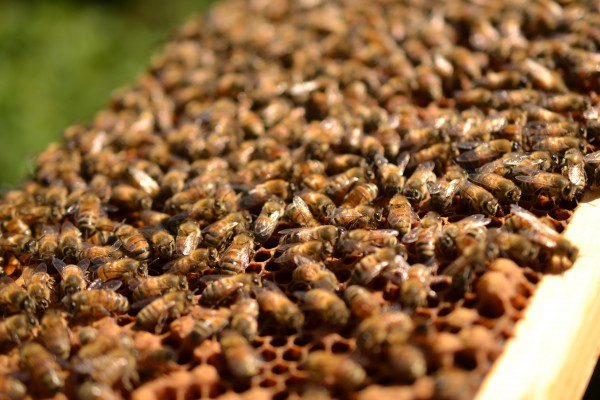
Busy as…bees?

Taking pictures of bees and hoping not to get stung
How Honey Gets Made
So how exactly do bees make honey? Bees visit flowers and gather sweet liquid nectar from the flower. They suck up the nectar through a long straw-like tongue called a proboscis. They store the nectar in a special honey stomach inside their bodies. When they fly back to the hive, they regurgitate the nectar. The house bees then ingest the honey and regurgitate it again. Each time they ingest the nectar, their stomachs help break down the sugar with an enzyme known as invertase that converts the sugar into honey.

The bees then drop the honey into the honeycombs, and then fan the honey with their wings to get rid of extra moisture so that the liquid becomes more viscous. Once the honey is ready, the bees cover it with wax and store it for food over the winter.
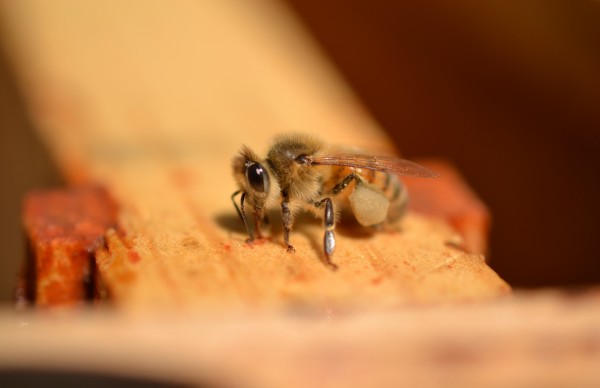
This bee has pollen (what looks like a white sac) on her back legs
In the process of visiting flowers, bees also pick up pollen, which they then transer from one flower to another, fertilizing the flower. The bees also use pollen mixed with honey to make “bee bread,” which they feed to baby bees. Pure honey will contain trace amounts of pollen. Some people believe that if you eat local honey it will help with your allergies to local plants.
Getting Honey From Bees to People
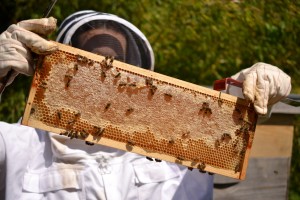
A frame filled with honey
To get the honey from the bees to people, the beekeeper uncaps the wax and then puts the frames into a centrifuge that spins out the honey. Then they run the honey through a filter and put in jars. For a typical 8,000-bee hive, the bees will need about 80 pounds of honey to feed themselves through the winter. If a beekeeper harvests honey in the fall, he or she will have to do a careful calculation to make sure to leave plenty of honey to get the hive through the winter.
Interesting note: As long as you keep honey away from moisture (don’t put it in the fridge), it does not spoil. Explorers have found honey, still in edible form, in ancient Egyptian tombs dating back about 5,000 years.
Starting Your Own Bee Hives?
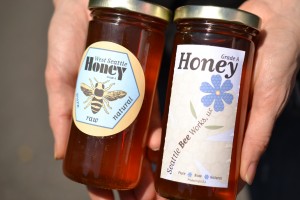
Some of Krista’s honey varieties
The honey from Krista’s hives, which is pure and raw, is sold in select Seattle retail shops. Varieties include Wildflower, Blackberry, Fireweed, and Knottweed. If you’re not in Seattle, Krista urges you to buy local honey from the area closest to you. You may be able to find a good source through your local beekeepers’ association.
If you’re thinking of starting your own urban beekeeping operation, check with your local laws to make sure it is permitted. (Also check in with your local beekeepers’ association for advice and assistance.) Finally, remember that you don’t necessarily need a spacious garden. In fact, one of Krista’s apprentices set up beehives on the roof of her apartment building (with the OK of the building owner and other residents.)
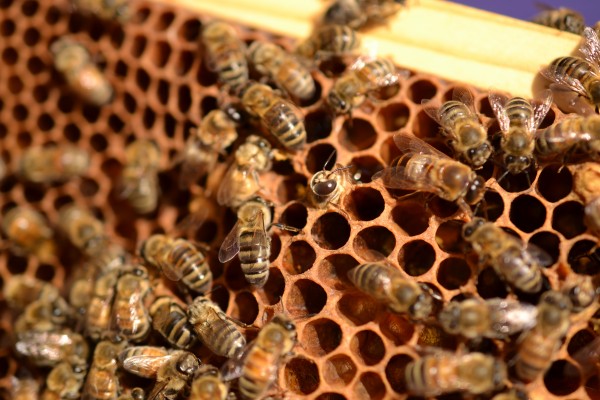
In the center, a “cute” newborn bee pops its head out of the comb
As for our family, we look at honey differently now. For one thing, we admire how much affection and respect the beekeepers have for the bees. They treat them like treasured companions (one beekeeper affectionately referred to them as ‘cute’). And second, it’s amazing to think of how much work these creatures put in to creating honey. It makes us hate to think about wasting it.
Buy Local Honey
Last but not least, this trip gave us a renewed interest in buying local honey. Of course, since last year when stories came out about “honey laundering” of illegal Chinese honey laden with antibiotics and chemicals, we have wanted know where our honey was made. But now we feel an extra loyalty toward our local bees, and we want to know that these hard-working creatures are treated with care and affection. From now on when someone asks us about honey, we’re going to answer confidently.
Like it? Pin it!

Urban Beekeeping and Real Honey

 Hi! I'm Jeanne Fratello - a writer, reporter, and food enthusiast who is on a mission to write great stories about food and where your food comes from.
Hi! I'm Jeanne Fratello - a writer, reporter, and food enthusiast who is on a mission to write great stories about food and where your food comes from.
Hi Jeanne,
I enjoyed reading this story.
Thanks – it was a great day!
So cool! I’ve been especially interested in honey bees since the Pollinator Picnic at BlogHer Food. Thinking about all the crops (90% of crops I think!) that rely on honey bees is pretty mind boggling. We all need to be doing more for bee populations!
p.s. did you just redesign the blog? Love the way it looks!!
Thanks, and yes! Glad you like it!
Love the pollen-bee photo!
Ok, I did not need to know about how many times the nectar was regurgitated by a bee!! I will try to forget that. And 5000 year old honey? Cool!
But it’s so delicious, you can look past that, right? Right?